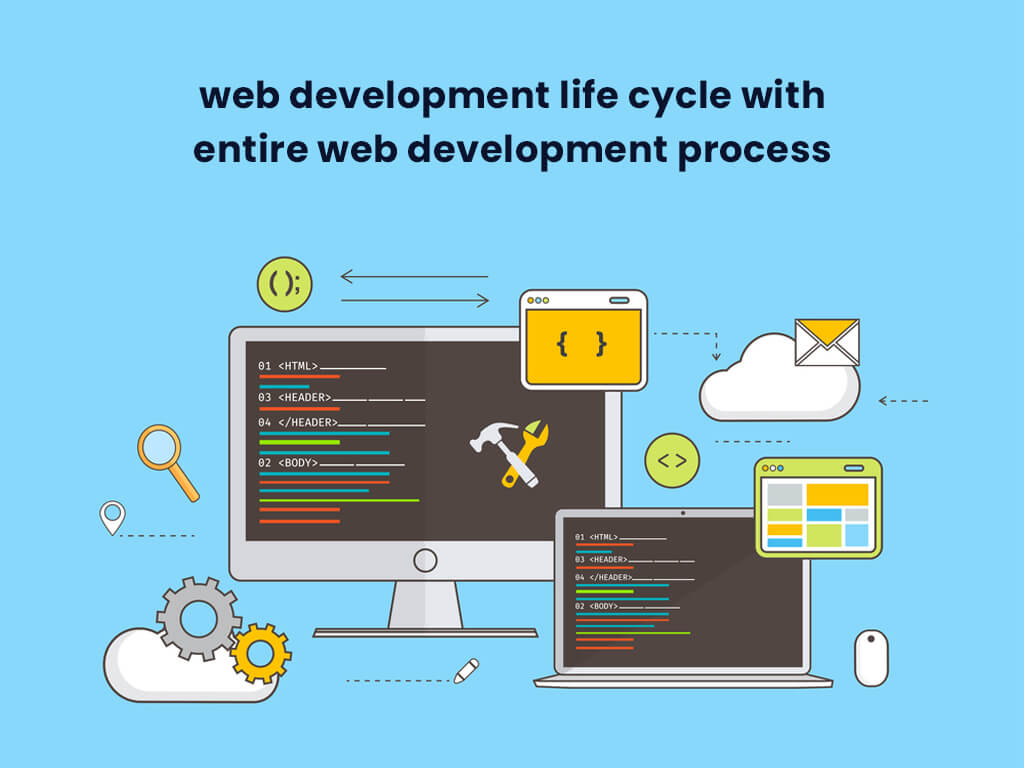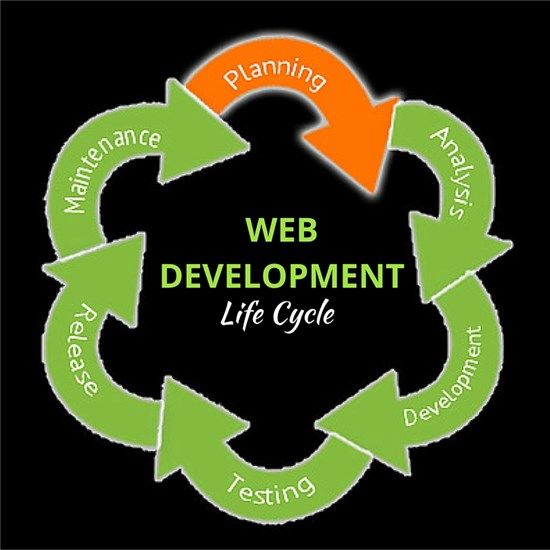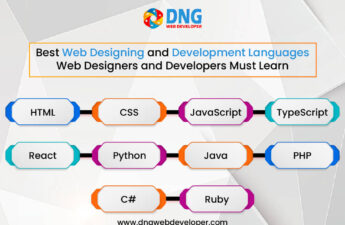As almost every business company is using high-performing websites or web applications to promote their businesses and also satisfy every need of customers, the demand for strong and developed websites has increased a lot. Whether it is a small or a large company, almost all the companies of different fields are focusing on building a well-designed and high-performing website for promoting their services and products to the whole world. Therefore the web development process has become necessary.
However, the web development life cycle does not only include coding. Numerous steps need to be followed to develop a website correctly. Remember that you have to strictly follow all the steps of the web development cycle if you want better performance. Generally, there are 7 steps of the web development life cycle that you need to follow strictly to get a high-performing and unique website.

In this blog, we will describe the entire web development process in detail, discussing the 7 important steps involved in the website development cycle.
What is the Web Development Life Cycle?
Web development life cycle is quite similar to the software development life cycle.
Web development life cycle is a continuous journey that can be better each and every day. It involves 7 different phases of Web development.
Web development life cycle comprises all the important steps from research and analysis to the maintenance of any website.
Not only the web developers, the whole team from the server-side, marketing side and client-side must have a basic knowledge about the web development life cycle to build an extraordinary website.
7 Stpes to Follow Website Development Life Cycle
If you are also running a business and want to build a better-performing website to promote your brand, then this blog is the perfect guide for you. We have mentioned below the entire web development process and the 7 important steps of web development life cycle.

1. Research and Analysis

This is the first and most vital step in the web development process every developer must follow. In this step, you have to research everything before designing and making the content for your website. In this step, you need to research and analysis the following points:
- The main purpose of the website.
- Know the target audience
- Each and every need of your customers
- Competitor analysis
- Why users need your website
- Demand for your service and website
- The expectation of the users from your website or web application.
- Budget estimation
In this step, you also need to analyze your website and web application development ideas and check if it is profitable for your business. By following this essential step, the whole web development team will get a clear idea of their works with correct definitions.
Therefore, if this step is avoided, all the remaining phases in web development life cycle become irrelevant and you cannot get better performance from your website.
2. Planning

The Planning phase includes robust strategies regarding the design, content, technology and marketing of the website. Based on the information collected and analyzed in the first step, decisions are built about the features and structure of the website.
In this step, a good team is formed with expert team members so that they can plan everything in a better way.
Deciding on the content structure, selecting the technology stack and software development methods, building a good sitemap and wireframe, allocation of resources and many more are very important parts of the Planning phase.
3. Designing

This is one of the most crucial phases of web development life cycle. This phase includes designing the layout of a website, and wireframing.
The layout includes creating a rough sketch, which might be graphical, for getting a feel of the website designing. The main purpose of the website layout is to display an information structure, setting up a visual tour of the content.
You also need to design the wireframe in this phase. After designing the wireframe, it needs to be transformed into tabs, menus, buttons, dashboards, graphics, colour themes,web typography to make a base layout of the website.
While designing a website, you need to keep in mind the target audience research and make design according to their preferences and expectations. Create an interesting and attractive design to make your website interesting and protect it from becoming mundane. Add attractive and unique graphics, colors, and other media to gain more attention from the users.
4. Content Creation
Content is the most essential asset of a website. Catchy content can help you to attract more users to your website and also allow you to communicate with your clients and readers very easily. Many times good content helps you to gain more revenue.
A website is created to offer valuable information to all users. Therefore you need to create clear, relevant, attractive and easy-to-understand content. Creative headlines, attractive writing, line editing, strong call-to-action buttons, and updating texts help you to create good content and attract more people to your website.
Also, you need to build SEO-optimised content to make your website SEO-friendly.
This phase helps you to improve the branding and marketing of your website or web application and allows you to define your website’s purposes through content writing.
5. Coding and Development
This is the most crucial phase of the web development cycle, and you must not ignore this essential phase while developing your website.
This phase includes the actual creation of the website. You need to do the coding carefully with the appropriate coding languages to make your website or web app most successful. After that, you have to develop the client-side and server-side of your website. This is the most time-consuming phase of the entire web development life cycle.
You have to do both the Front-end and Back-end development to get the best performance from your website.
In the Front-end development step, mainly Front-end developers create websites. The most appropriate coding languages for the front-end development are- Java Script, HTML and CSS so on. Front-end developers also use some frameworks such as React, Vue, Angular, and many more Front-end development.
Back-end development includes the complete development of the various features of a website. While the front-end developers create the visual elements and deal with the client-side, the back-end developers instruct every element of a website to perform the needed functions. The best coding languages for back-end development are PHP, Python, Ruby, SQL and so on.
6. Testing the Website
Before finally launching the website, every developer must test the website several times to ensure its better performance and better user experience.
Testing is one of the most essential phases of a web development life cycle, as it plays a vital role in securing the website. If there is an issue in your website, it can be easily identified by testing the website. Once you identify the issue, you can remove it and make the site perfect.
The testing phase includes the following tasks:
- Testing the speed of the website
- Security checking
- Test the loading of the website
- Admin checking
- Check the mobile-friendly appearance
- Check the user interference
- Test the stress
You must do all these tests to ensure that the website does not have any bugs. If you avoid this phase, many errors can occur on your website that will impact the performance of your website and decrease its quality.
You can test your website with several latest tools such as Test IO, Webload, Spider, Net sparker, W3C link checker and many more.
7. Maintenance
Once you get the approval from the QA team, your website or web app is finally ready for deployment and launching. However, do not think that the web development process ends here. Maintenance is the last but important phase of the web development life cycle.
After launching the website, you need to do the maintenance of your website frequently to make it better and offer the best performance to all the users. Regular maintenance and frequent updates are extremely essential to keep the website performing perfectly and engage more users.
All the phases of the web development life cycle are very important for your website. Therefore you need to follow all these phases to create the best-performing website for attracting more users and growing your business.
For getting a better and well-developed website, you can connect with DNG Web Developer, one of the greatest Web development agencies in Gujarat. Our expert team has enough knowledge and experience in the web development team and they will provide you with a better performing website and also do the regular maintenance of the website.


